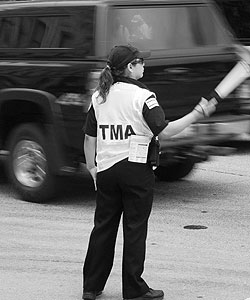 The Trib is reporting that "about 80" traffic-control aides—the neon-yellow-vested workers who guide cars at city intersections—are getting laid off; ABC7 reports that it’s 97 positions if you include vacancies. Either way, it’s around half.
The Trib is reporting that "about 80" traffic-control aides—the neon-yellow-vested workers who guide cars at city intersections—are getting laid off; ABC7 reports that it’s 97 positions if you include vacancies. Either way, it’s around half.
It’s not the first time it’s happened—traffic-aide layoffs were cut back in Mayor Daley’s 2008 budget, though the number before today’s layoffs was up about 40 full-time positions from 2006.
As much as no reasonable person likes to see anyone laid off in these economic times, I suspect that the move will be politically popular. In my admittedly anecdotal experience, the argument against them is that they’re redundant. Or even distracting, confusing drivers when their instructions go against traffic signals.
But asking drivers whether or not a particular traffic safety feature works is no way to make traffic policy, because drivers abhor anything that seems to complicate getting from point A to point B—roundabouts come to mind—even when new patterns are in their best interests. Lots of traffic science runs against perception, such as the terrifying-looking diverging diamond interchange.
And redundancy isn’t always bad in traffic control. Consider the speedometer signs that tell you when you’re speeding:
In other words, officials in Garden Grove were betting that giving speeders redundant information with no consequence would somehow compel them to do something few of us are inclined to do: slow down.
The results fascinated and delighted the city officials. In the vicinity of the schools where the dynamic displays were installed, drivers slowed an average of 14 percent. Not only that, at three schools the average speed dipped below the posted speed limit. Since this experiment, Garden Grove has installed 10 more driver feedback signs. “Frankly, it’s hard to get people to slow down,” says Dan Candelaria, Garden Grove’s traffic engineer. “But these encourage people to do the right thing.”
That’s the best argument I can think of for traffic aides: it’s not so much redundant as complimentary, giving drivers a second reason to be aware (and thus to drive more slowly) and an additional, perhaps more effective, reminder of traffic laws. For all my instincts against the idea of traffic aides, they do seem to cut down on my biggest traffic pet peeves, drivers who pass through green lights only to sit in a crowded intersection, and pedestrians who cross at green turn signals.
But that’s different from whether they actually reduce congestion and accidents. I couldn’t find any research. Neither could Tom Vanderbilt, author of the excellent book Traffic, who does make a good point about the perceived inefficiency of traffic cops:
The first thing to note is that in the world of traffic, every case needs to be taken on its own; so without extensive study of the flows and geometries of that particular intersection, it would be hard to offer concrete analysis. And I’ve not seen hard-core studies analyzing human control versus signalized control (but if anyone has, please let me know).
[snip]
So the intersections where we tend to see human traffic cops tend to be the worst intersections to begin with (we don’t see them at the empty well-flowing intersections), and seeing them may reinforce the idea that they are somehow making things worse. In fact, things would probably be far worse in their absence. The traffic cop is a sign of our own failure; if we did as we were told, human supervision would not be needed.
The number of people injured in car crashes in Cook County did decline substantially from 2003 (60,214) to 2009 (38,697), according to IDOT data. NHTSA data shows a similar drop in fatalities. But the IDOT data also shows declines in crashes overall and the "mileage death rate" (which corrects for vehicle miles traveled) over the same period of time, and the NHTSA data shows declines in Illinois’ rural areas and more broadly nationwide.
Without specific studies about traffic-aide effectiveness it’s hard to say what the result of eliminating almost 100 positions will be, but I suspect either way the political costs are very low.
Photograph: -Tripp- (CC by 2.0)



